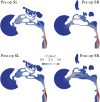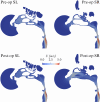On the comparison between pre- and post-surgery nasal anatomies via computational fluid dynamics
- PMID: 37902893
- PMCID: PMC10902155
- DOI: 10.1007/s10237-023-01776-5
On the comparison between pre- and post-surgery nasal anatomies via computational fluid dynamics
Abstract
Nasal breathing difficulties (NBD) are widespread and difficult to diagnose; the failure rate of their surgical corrections is high. Computational fluid dynamics (CFD) enables diagnosis of NBD and surgery planning, by comparing a pre-operative (pre-op) situation with the outcome of virtual surgery (post-op). An equivalent comparison is involved when considering distinct anatomies in the search for the functionally normal nose. Currently, this comparison is carried out in more than one way, under the implicit assumption that results are unchanged, which reflects our limited understanding of the driver of the respiratory function. The study describes how to set up a meaningful comparison. A pre-op anatomy, derived via segmentation from a CT scan, is compared with a post-op anatomy obtained via virtual surgery. State-of-the-art numerical simulations for a steady inspiration carry out the comparison under three types of global constraints, derived from the field of turbulent flow control: a constant pressure drop (CPG) between external ambient and throat, a constant flow rate (CFR) through the airways and a constant power input (CPI) from the lungs can be enforced. A significant difference in the quantities of interest is observed depending on the type of comparison. Global quantities (flow rate, pressure drop and nasal resistance) as well as local ones are affected. The type of flow forcing affects the outcome of the comparison between pre-op and post-op anatomies. Among the three available options, we argue that CPG is the least adequate. Arguments favouring either CFR or CPI are presented.
Keywords: CFD; Constant power input; LES; Nasal flow; Nasal resistance.
© 2023. The Author(s).
Conflict of interest statement
The authors have no relevant financial or non-financial interests to disclose.
Figures










Similar articles
-
Importance of the numerical schemes in the CFD of the human nose.J Biomech. 2022 Jun;138:111100. doi: 10.1016/j.jbiomech.2022.111100. Epub 2022 Apr 27. J Biomech. 2022. PMID: 35533422
-
Review of computational fluid dynamics in the assessment of nasal air flow and analysis of its limitations.Eur Arch Otorhinolaryngol. 2014 Sep;271(9):2349-54. doi: 10.1007/s00405-013-2742-3. Epub 2013 Oct 8. Eur Arch Otorhinolaryngol. 2014. PMID: 24100883 Review.
-
Sensitivity of nasal airflow variables computed via computational fluid dynamics to the computed tomography segmentation threshold.PLoS One. 2018 Nov 16;13(11):e0207178. doi: 10.1371/journal.pone.0207178. eCollection 2018. PLoS One. 2018. PMID: 30444909 Free PMC article.
-
Creation of an idealized nasopharynx geometry for accurate computational fluid dynamics simulations of nasal airflow in patient-specific models lacking the nasopharynx anatomy.Int J Numer Method Biomed Eng. 2017 May;33(5):10.1002/cnm.2825. doi: 10.1002/cnm.2825. Epub 2016 Sep 21. Int J Numer Method Biomed Eng. 2017. PMID: 27525807 Free PMC article.
-
[Three-dimensional analysis of nasal physiology : Representation by means of computational fluid dynamics].HNO. 2018 Apr;66(4):280-289. doi: 10.1007/s00106-017-0443-8. HNO. 2018. PMID: 29222682 Review. German.
References
-
- Brüning J, Hildebrandt T, Heppt W, Schmidt N, Lamecker H, Szengel A, Amiridze N, Ramm H, Bindernagel M, Zachow S, Goubergrits L. Characterization of the airflow within an average geometry of the healthy human nasal cavity. Sci Rep. 2020;10(1):1–12. doi: 10.1038/s41598-020-60755-3. - DOI - PMC - PubMed
-
- Calmet H, Pastrana D, Lehmkuhl O, Yamamoto T, Kobayashi Y, Tomoda K, Houzeaux G, Vázquez M. Dynamic Mode Decomposition Analysis of High-Fidelity CFD Simulations of the Sinus Ventilation. Flow Turbul Combust. 2020;105(3):699–713. doi: 10.1007/s10494-020-00156-8. - DOI
MeSH terms
LinkOut - more resources
Full Text Sources
Miscellaneous

